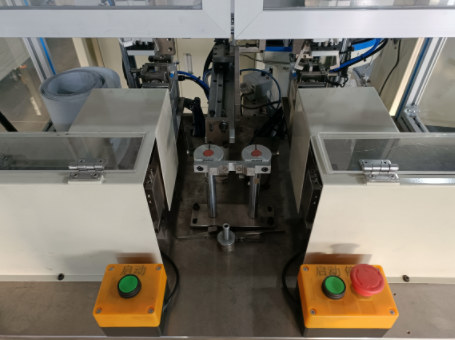What are the common electrical faults and solutions for the series excitation motor motor semi-automatic spring brush machine?
The common electrical faults and solutions of semi-automatic spring brush machine for series excitation motor motor are as follows:
1、Brush related faults
Brushes wear out too fast:
Reason: may be poor quality brushes, excessive spring pressure, rough commutator surface or motor overload, etc..
Solution: Replace the brushes with qualified quality; adjust the spring pressure to a suitable range, generally 1.47×10⁴~2.45×10⁴pa; polish and smooth the commutator surface; check the motor load to avoid overload operation.
l Brush spark is too large:
Reason: poor contact between brush and commutator, brush wear too short, uneven spring pressure on brush, loose brush grip, brush grip too far away from commutator surface, brush grade does not meet the requirements, short circuit of commutator pole coil, disconnection of armature winding, etc. 1.
Solution: Grind the brush surface to make good contact with the commutator, and replace the brushes with new ones if necessary; adjust the spring pressure so that the pressure on each brush is even; tighten the brush grip bolts so that the brush grip is parallel to the surface of the commutator; adjust the distance from the brush grip to the commutator to about 2 mm; replace the brushes with brushes that meet the requirements; rewrap the commutator coil; dismantle the motor and check the armature windings, and use a millivoltmeter to find out where the breaks are and repair them or rewind them13. rewind 13.

2、Winding Failure
l The winding is short-circuited:
Reason: The winding may be short-circuited between turns or phases due to insulation damage, moisture, overheating, overload, etc. .
Solution: Use insulation resistance meter to check the insulation resistance of the winding. If the insulation resistance is too low, dry the winding or replace the insulating material; for serious short-circuited winding, it needs to be rewound.
l The winding is disconnected:
Reason: loose winding joints, poor welding, broken wires, etc. .
Solution: check the winding joints, re-weld the loose place; if the wire is broken, find the broken point and connect it, if it can not be repaired, the winding needs to be rewound.
3、Commutator failure
l Mica protrudes between the commutator pieces:
Reason: the mica piece is not carved in place or the mica piece is not evenly worn during the motor operation.
Solution: Carve away the remaining mica with a hand puller, so that the mica sheet is lower than the surface of the commutator sheet by about 0.5-1 mm.
l The commutator surface is worn or strained:
Reason: Friction between brush and commutator, vibration of motor, impurity on commutator surface, etc.
Solution: Turn or grind the surface of the commutator to make it smooth; clean the impurities on the surface of the commutator; check the cooperation between brushes and the commutator and replace the brushes if necessary.
4、Other electrical faults
l The motor overload protection operates frequently:
Reason: the load may be too large, improper motor selection, low supply voltage, etc.
Solution: Check the load situation, adjust the load size reasonably; select the appropriate power motor according to the actual load demand; check the power supply voltage, if the voltage is too low, find out the reason and take measures to stabilize the voltage.
l Motor leakage:
Reason: Damaged winding insulation, damp motor, water in junction box, etc.
Solution: Insulate the winding, such as drying, dipping paint, etc.; dry the motor; check the sealing of the junction box to prevent water ingress, and dry the damp junction box.
※ If the above ways and means still can not solve the equipment failure, please contact Xinhui Electromechanical Equipment Co., Ltd. through the page chat tool to seek help.







